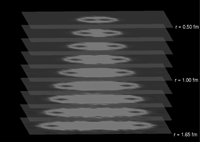QCD Simulations: Minuscule Particles, Gigantic Computations
June 30, 2003

QCD simulation of "quark confinement." The energy between two heavy quarks increases with the distance between them. Computation of the distance at which this "flux tube" will break is a "grand challenge" (petaflop) computer simulation problem. Image and computation produced by the computational physics group at Universit�t Wuppertal.
Lattice QCD simulations are a challenge for today's and tomorrow's (petaflop) supercomputers. Indeed, the QCD community has been the driving force in several efforts to develop future high-performance computers. Because the core computations reduce to the solution of linear systems and the calculation of matrix functionals for very large matrices, lattice QCD simulations are also a challenge for numerical linear algebra. Efficient methods require techniques that exploit the structure, the nontrivial symmetries, and other special properties of these matrices.---Andreas Frommer, Fachbereich Mathematik, Universit�t Wuppertal.

